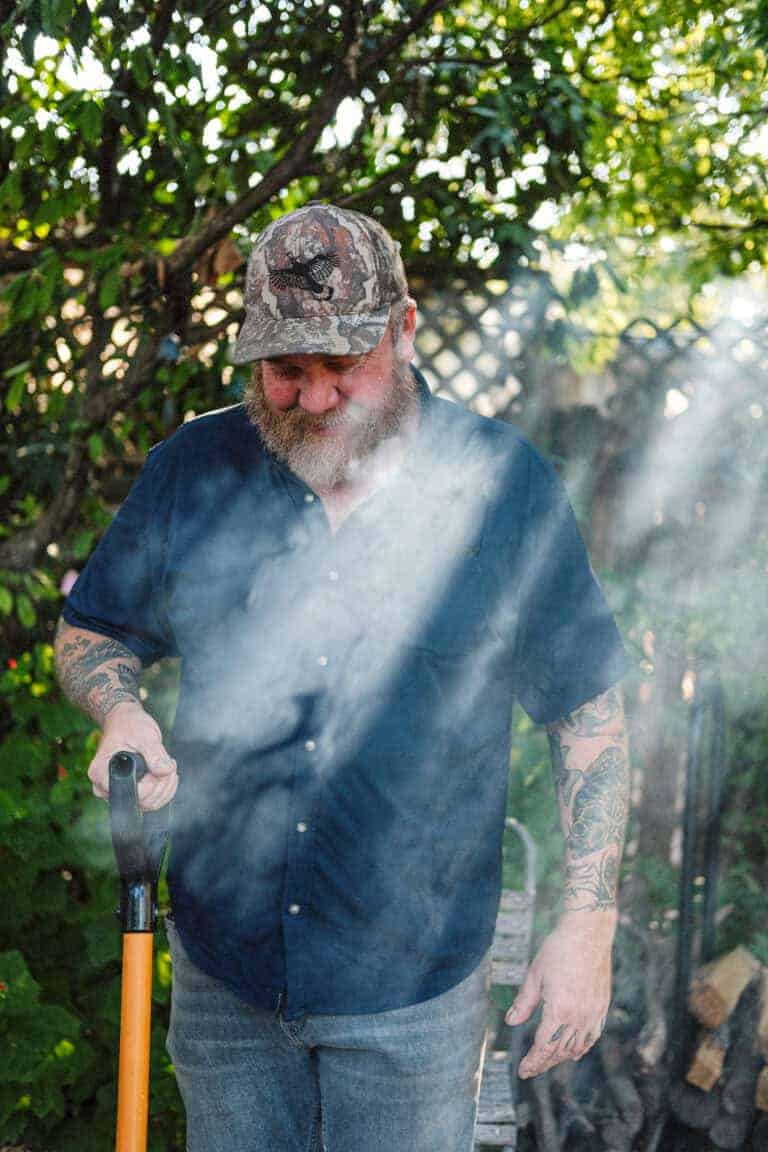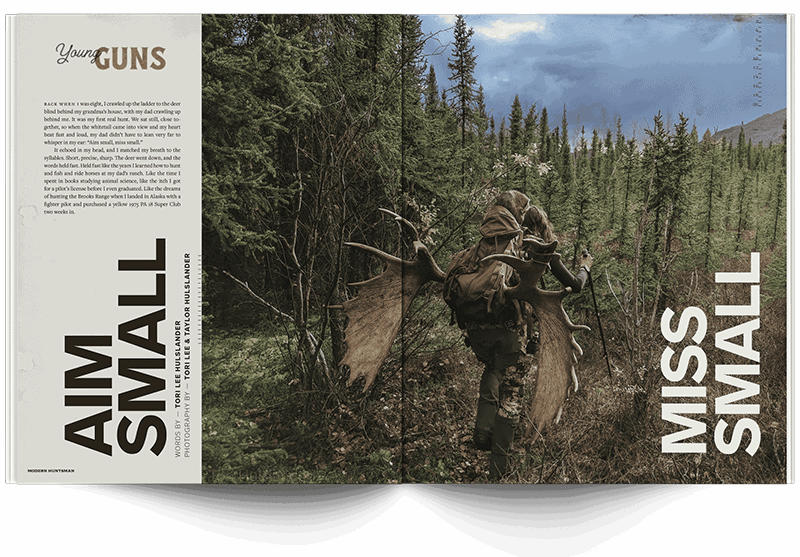The ambient noise of waves crashing and birds singing their approval breaks over the line first. Sarah Glover is checking the surf report when she answers my call from half a world away. Her Australian accent and easy, joyful laugh place her perfectly on the sunny coast of Tasmania, where she was born and raised and resides again today. A childhood of island exploration, and tea breaks to play in the kitchen, led her to culinary school at 16. An education in traditional French cuisine took her on a laborious path where the mile markers included her own restaurant in NYC, and a bakery in Bondi Beach, before she returned home to find that the recipe for her own life was waiting in the bushland of ‘Tassie.’
For Chef Glover, the missing ingredients were always fresh air and an open flame. Today, she takes people outside and off-grid with her catering business, Wild Kitchen. Armed with a knife, and a few basic tools of the trade, Sarah teaches workshops for adults and children alike, where she encourages people to use local ingredients from the farm, field and sea in their quest for self-sufficiency.
The author of the Wild Adventure Cookbook shares her thoughts on ingredient sourcing, wild game cooking, international food traditions, recipes for fresh kangaroo, and what she isn’t rogue enough to try.
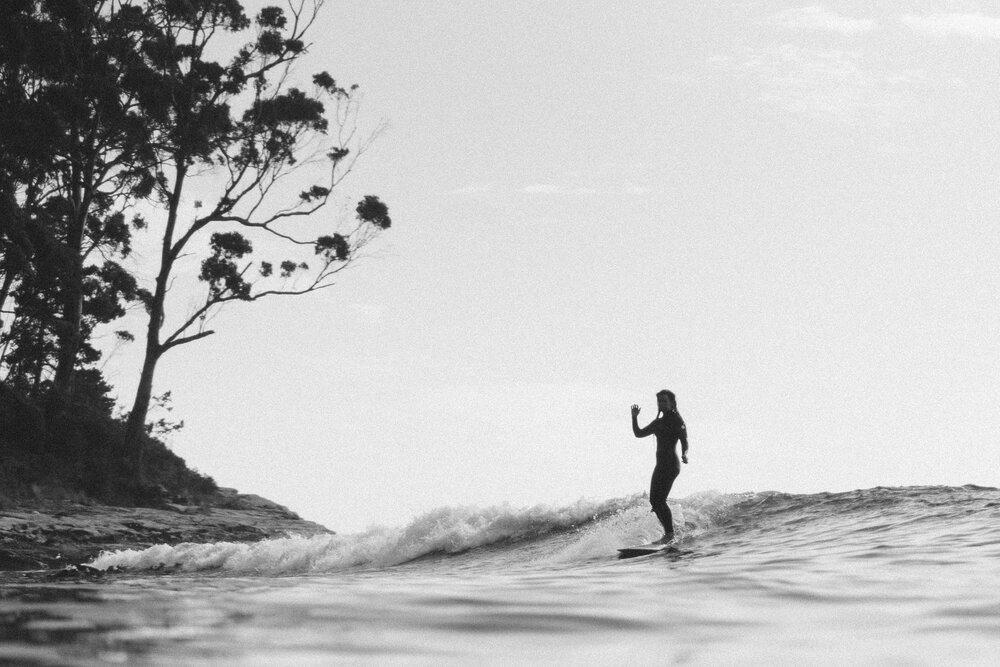
KATIE MARCHETTI — Why don’t you tell me a little bit about your upbringing? What was family life like, and how did you discover your love of cooking?
SARAH GLOVER — I grew up in Tasmania, or Tassie for slang. Australians like to abbreviate — we shorten everything we can! My parents had my two older brothers and me, and then they actually had an eight-year gap and then had five more; so I’m one of eight kids, with five brothers and two sisters. My parents decided to homeschool us, which wasn’t really a trendy thing to do back then. We had this amazing house that was on the water, and there was a bit of a bushland in front of us. My brothers and I were always really adventurous. We loved being outdoors, and would try and do school as quickly as we could so we could run out the front door and go exploring. We were always going down to the waterfront to dive and fish and surf. It’s actually quite cold in Tassie, but I don’t ever remember it being cold as a kid. My mom said we’d come back from surfing and would be blue and she’d ask, “How was it?” And we’d say, “It was awesome!”
There was a golf course down the road from us that was quite high-end, and we used to run across it and go diving for golf balls, then sell them back to the course for money to buy fish and chips.
I don’t really remember schoolwork so much, but I definitely remember having our morning tea break, and we would all jump into the kitchen and just start experimenting and baking and trying to come up with new things to eat. We used to make cakes, cause there was never anything pre-bought, and we always liked cooking with sugar. Cooking started as a bit of an escape from schoolwork, which I didn’t really like. I just loved being outdoors.
My dad’s family, the Glovers, are Merino wool sheep farmers up the east coast of Tasmania. So I kind of grew up there as a kid, going up for holidays, and we’d stay in the shearers quarters and go hunting on their property. Then we’d go up the coast to go surfing, and just had this lifestyle from a very young age. I guess you take it for granted when you don’t know anything different.
Later, I moved away from home, and went to culinary school and started to become a chef when I was 16. It was like very traditional cooking, all about the French style of cooking, very perfect. Everything was indoors.

KM— Where did you go to culinary school?
SG — I went to an institution called Drysdale, a TAFE Institute here, which is like a public kind of culinary school run by the government. That’s how they structured culinary school in Australia back then. My mom recognized that I liked cooking and that I was good at it. My friend’s mom was the head of Drysdale and asked, “Why don’t you come to Chef school here?” I really loved the tactile experience.
I worked in a little restaurant after, and we had an amazing chef who was very passionate about good-quality produce — he cooked really well. He would use lots of different types of game meat that not a lot of chefs really used at the time. I remember peeling ox tongues, and frying baby sardines that they catch here in Tassie, and quail and pigeon and duck and kangaroo. I got exposed to a lot when I was really young. Then I actually left when I was 21 to become a dietician and nutritionist, because I saw this disconnect between what people were eating and their health. So I went to study at university in Queensland because I wanted to experience something different.
It didn’t last very long, because my mind is more creative. I’m really glad, because I would have been stuck in a hospital and that would have been boring. So I moved to Sydney and I ran a cookie company. I did it because I wanted to be able to surf, so I lived in Bondi, surfed and made cookies from scratch.
Then I started traveling to New York for a period of four years on-and-off, because I sort of fell in love with America. I was dating a guy there at the time, and long story short, I had a restaurant in New York for a while. Later I moved back to Tasmania, and that’s when I realized how I loved being out in nature, how special what we had here on the Island was. I fell back in love with my childhood and the way I grew up cooking and adventuring.
I wrote my cookbook Wild Adventure; that book is based on things I would do in my spare time. I just got really passionate about showing people what amazing resources we have at our fingertips — if we are willing to get our hands dirty. I set it up in a way that was inspiring to people to try and create for themselves, from practical recipes.
KM — You now have a cooking school as well as a catering business — tell us about that.
SG — I have a catering business called the Wild Kitchen where I cook off-grid, over open fire, using local produce from the area. I cook a lot of whole animals, use a lot of deer, and I try to use a lot of invasive species and things like that as well. In Tasmania, we’re allowed to kill wallabies because there’s so many of them. We also have a problem with fallow deer on the Island, which are an introduced species.
And yeah, I also do workshops to teach people to cook. They’re mostly around Australia right now because of the lack of travel during the pandemic. I just try to give people a hands-on experience with cooking over fire, using whole cuts of meat, teaching a bit about butchery; teaching them how to cook protein in a way that’s outside the frying pan.
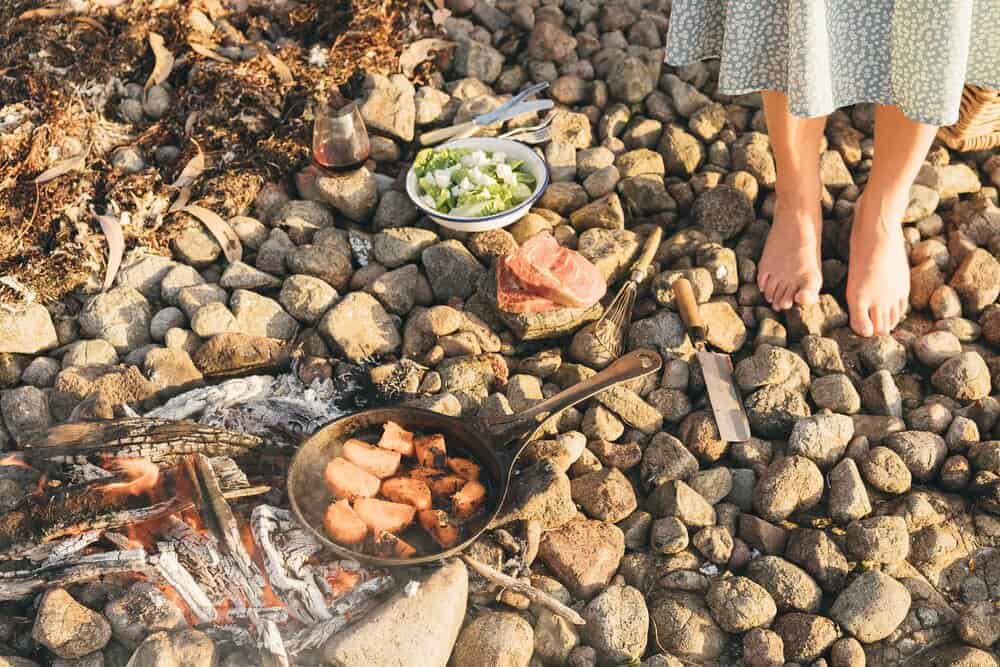
I’ve just written a kids adventure cookbook that’s coming out in April, 2021, and that’s a spinoff called Wild Child. I just did a kids workshop — we have a local fish here called Flathead, and it’s really sweet eating, it’s delicious. I don’t think the kids had ever seen an actual Flathead, and so I made them truss and stuff whole fish on little sticks, and then cooked them by the fire. They seemed so tormented, and said, “I think we’re all vegetarian now.” I asked them, “Where do you think your fish came from?” They loved the activity of cooking it and stuffing it by the fire, but then when it came to eating it…it was really funny, because they didn’t quite know how to approach it. They’re just used to getting it presented as a beautiful filet. And now they’re thinking, how do I navigate through its skin and its face?
KM — Teaching kids to cook, that’s such a unique tactic. What made you decide there was a gap that needed to be filled?
SG — For me, as a child, our family memories were built around going hunting or fishing, or we would do an activity together that was in nature. When I lived in New York and Sydney, I started to see kids whose adventure was going to a cafe and their activity was playing with an iPad. There’s so much disconnection now; people aren’t creating memories in nature anymore. You don’t remember the meal you had at a cafe the same way you remember going fishing with your dad, or having a meal with your family.
So I just got really passionate about teaching kids as well as adults to create memories together around food, and to know how to plan their adventures. We grew up as kids who would run down or ride our bikes to the store to check the newspaper for the weather forecast, just to see if there was surf or what we could do, you know?
I’m so well-trained in checking the weather now and predicting how things are going to happen, that I can plan my adventure around that. Nowadays most kids don’t know how to do that, sometimes to the point where it’s dangerous. Sadly there was a local kid here that went kayaking when a huge storm came. And he died, and I thought, Surely you would have checked the weather forecast. There is such a disconnection now to being able to build awareness around things like the weather and nature and the food we source. So I guess my passion is showing people this through my workshops.
KM — That’s really incredible. The theme for the issue is resilience, and I feel like this speaks to that — a need for self-sufficiency — and of being aware of where we’re placed in the world. What do you think are the most important life skills for people to learn from these workshops?
SG — I think being confident with handling a fish or a bigger cut of meat. I think people just lose confidence because we’ve sort of grown up under the idea of perfectionism, and don’t want to try things because they don’t want to fail. So it’s breaking it down and making it accessible. I think there’s a respect that you end up having for your produce as well. Not everyone can go and catch their own seafood or fish every day, but it’s great for them to feel confident when they go to the butcher or the fish market — they will have a greater awareness and appreciation for the life that was taken.
KM — That’s so important. What’s been the best part of this cooking journey for you?
SG — The moments you gain a connection with people and the places I get to go. I think everything needs to come back to community, because it’s such an amazing gift that we have. I feel, in this day and age, we’ve become very disconnected from it because of social media, and we just end up sitting on our phones, looking at things that we don’t commit to actually having.
I wouldn’t have written my cookbook, Wild Adventure, if it hadn’t been for people opening their homes and giving me boats and lending me islands and different things. The book, and what I do, wouldn’t have had the spirit that it has if it wasn’t for people. I think we need to get away from consumerism and appreciate human life, and know that life in general is such a gift.
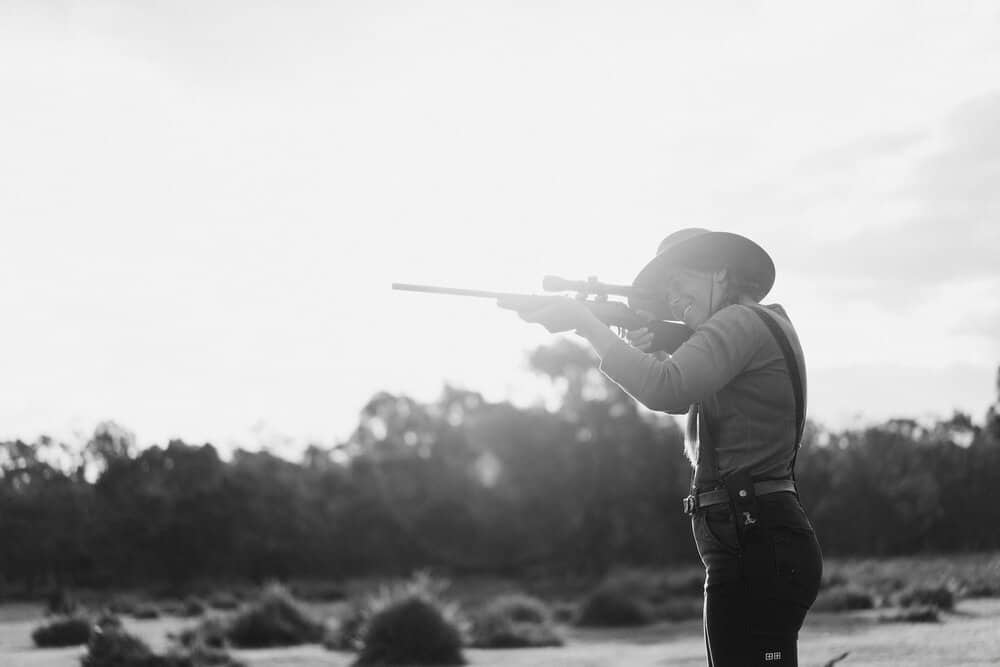
KM — That’s an incredibly powerful message to bring people through food. What do you think has been the most difficult part of this?
SG — I think stepping out of what the normality is can be lonely at times. Choosing to forge your own path can be isolating, and having enough guts to believe in your vision, and not being derailed by other people’s views. I would never do what I’m doing if I had listened to everybody else; I would have just stayed in the kitchen with the metal benches and not have stepped outside of that to risk failure.
KM — When you host these catering events, what has been the public response to you using food sourced via hunting?
SG — It’s funny, because I grew up in a family that hunts, and Tasmania is an island of farming. So it’s only lately I have seen pushback when posting a couple of things about me hunting on social media. It surprised me. I’ve grown up doing this my whole life. I didn’t really think twice that it was abnormal. Recently, when I went hunting, I posted a photo and I lost 1,200 followers.
It’s just this huge detachment that we’ve got, because it’s not normality anymore. I guess with what I do, it’s like, “Hey, I’m just trying to live true to who I am and show that this is actually normal; salami’s from a pig that has been killed and gutted.” You should be admired for the fact that you would take the time out to do this, and find a wild resource and use it sustainably. This is the way it has been since the foundations of time. But, you know, with what I do, they either love it or hate it.
It’s not just about meat for me, though. I’ve had vegetarians hire me for their wedding and they love what I do. So I catered a vegetarian menu for them, and I’m totally happy to do that because vegetables are amazing! My great-grandparents were carrot farmers, and it’s hugely important to me where things are sourced from. And that education needs to happen. So when I’m catering, people love to watch and ask questions, and I encourage it. I encourage people to talk to us. That does require more energy, but our catering is a labor of love.
KM — What’s your favorite species to hunt?
SG — My favorite species? Well, in Tasmania, we only have fallow deer and kangaroo, and rabbit — you have way more than we do! That’s about it for getting meat in Tasmania. On the mainland, we have wild pigs and goats and different varieties of deer. I haven’t been exposed to that a lot, because I just haven’t had the opportunity, which is why I am super excited to come to the States and learn more.
I’ve actually just gotten into duck hunting here; my uncle has a marsh and we have four species of duck we can kill there. Being on an island, it’s just so different. We don’t have as much, but we do have incredible seafood. So I dive a lot, for crayfish and every type of fish you can imagine — it’s a lot of fun.

KM — Do you have a favorite dish for introducing people to wild game?
SG — I quite like just cooking meat over fire, hanging it and smoking it for a long time while basting it in ghee. Keeping it simple, I’ll serve it with a herb-infused oil or something I might make. We cook a lot of kangaroo in this way. I like doing it in a way where you actually taste the meat. I also love making Kangaroo Tail Curry, which is really good as well. And then I’ve been loving the results of marinating venison in whiskey and pepperberry — that’s a native pepper tree that grows here in Tasmania and is a bit sweeter. After dry-aging the meat for a couple of weeks, I stick it in the marinade, and into the fridge for 48 hours, then cover it in foil and slow cook it for six hours in the Traeger with olive oil. It’s so good when you pull it off the bone.
KM — Where do you find inspiration for some of these recipes of yours?
SG — I’ve been interested in the cooking of Magnus Nilsson, who’s quite a famous chef from the Faroe Island. They still hunt whales there, and his book includes recipes for whale blubber. It’s so interesting, because on a lot of these islands, they have hunted the same way for centuries. They have these old ways of cooking things, and I wanted to learn their methods; these old women cook under the ground and they use all these different herbs and spices and techniques that I think we could learn a lot from.
There’s just so much to learn from these countries. For example, countries that have super brutal winters, and the way they used to preserve and keep meat. And I think we can modernize it as well, but I do think there’s something to be learned from it.
KM — What’s the wildest place you’ve ever cooked?
SG — I would have to say Tasmania — it’s such a wild island. Honestly, you can have five seasons in one day. But being on the top of Tassie on Flinders Island was probably the wildest. We took a boat out to where they harvested mutton birds, just how they used to do it back in the ‘70s. We pulled them from their burrows on the beach, which was pretty cool. It’s incredible, but they’re very gamey.
KM — What’s the wildest item in your kitchen?
SG — The wildest item in my kitchen would have to be the machete given by my friend, Juan, who is a chef from Argentina. Everyone needs a machete.
KM — What’s the wildest recipe you’ve tried?
SG — Probably kangaroo heart — pretty crazy, but it’s also surprisingly delicious. I have an indigenous friend, and he and his son go hunting and they actually clobber kangaroos because it’s their tradition and their culture. He was telling me they eat the heart while it’s still beating, which just sounds brutal. His four-year-old son loves it. Little too hardcore for me.
I really enjoy hunting though. I like the process and the thrill you get from it. Although hunting itself can be hard, I think it’s even harder preparing, storing and looking after the meat afterward. I love to hunt obviously, but I think I like to cook it more, because I like the challenge of trying to do something new with the meat.
KM — Are most of your workshops and catering events in Tasmania?
SG — Yes! Next year I’m actually planning to do a bit of a tour over in America, which I’m excited about.
I think what’s quite interesting is that the history of Australian cuisine is very young. The Brits came in and, besides the indigenous culture, which is the Maori way of cooking over fire and under the ground, we don’t have a very rich history of a certain style of cooking. It is very raw in terms of meat and veggies. We are lucky to have such a rich ecosystem here with incredible produce, because we don’t have a huge population and we’ve got amazing resources in the land here.




